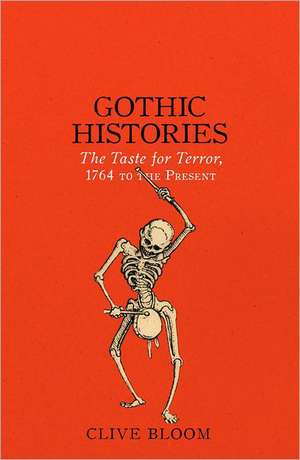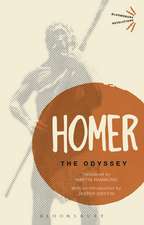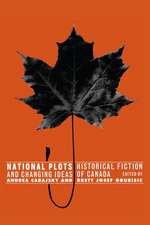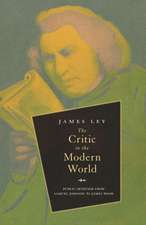Gothic Histories: The Taste for Terror, 1764 to the Present
Autor Clive Bloomen Limba Engleză Hardback – 6 apr 2010
In the middle of the eighteenth century the Gothic became the universal language of architecture, painting and literature, expressing a love not only of ruins, decay and medieval pageantry, but also the drug-induced monsters of the mind.
By explaining the international dimension of Gothicism and dealing in detail with German, French and American authors, Gothic Histories demonstrates the development of the genre in every area of art and includes original research on Gothic theatre, spiritualism, 'ghost seeing' and spirit photography and the central impact of penny-dreadful writers on the genre, while also including a host of forgotten or ignored authors and their biographies.
Gothic Histories is essential reading for anyone interested in the history of the Gothic and its literary double, the horror genre, leading the reader from their origins in the haunted landscapes of the Romantics through Frankenstein and Dracula to the very different worlds of Hannibal Lecter and Goth culture. Comprehensive and up-to-date, it is a fascinating guide to the Gothic and horror in film, fiction and popular culture.
By explaining the international dimension of Gothicism and dealing in detail with German, French and American authors, Gothic Histories demonstrates the development of the genre in every area of art and includes original research on Gothic theatre, spiritualism, 'ghost seeing' and spirit photography and the central impact of penny-dreadful writers on the genre, while also including a host of forgotten or ignored authors and their biographies.
Gothic Histories is essential reading for anyone interested in the history of the Gothic and its literary double, the horror genre, leading the reader from their origins in the haunted landscapes of the Romantics through Frankenstein and Dracula to the very different worlds of Hannibal Lecter and Goth culture. Comprehensive and up-to-date, it is a fascinating guide to the Gothic and horror in film, fiction and popular culture.
| Toate formatele și edițiile | Preț | Express |
|---|---|---|
| Paperback (1) | 119.46 lei 6-8 săpt. | |
| Bloomsbury Publishing – 6 apr 2010 | 119.46 lei 6-8 săpt. | |
| Hardback (1) | 484.71 lei 6-8 săpt. | |
| Bloomsbury Publishing – 6 apr 2010 | 484.71 lei 6-8 săpt. |
Preț: 484.71 lei
Nou
Puncte Express: 727
Preț estimativ în valută:
92.75€ • 101.06$ • 78.15£
92.75€ • 101.06$ • 78.15£
Carte tipărită la comandă
Livrare economică 23 aprilie-07 mai
Preluare comenzi: 021 569.72.76
Specificații
ISBN-13: 9781847060501
ISBN-10: 1847060501
Pagini: 224
Dimensiuni: 129 x 198 x 16 mm
Greutate: 0.43 kg
Ediția:New.
Editura: Bloomsbury Publishing
Colecția Continuum
Locul publicării:London, United Kingdom
ISBN-10: 1847060501
Pagini: 224
Dimensiuni: 129 x 198 x 16 mm
Greutate: 0.43 kg
Ediția:New.
Editura: Bloomsbury Publishing
Colecția Continuum
Locul publicării:London, United Kingdom
Caracteristici
First book to set the Gothic in popular culture e.g. areas such as 'goth lifestyle' as well as dealing with its more serious side
Cuprins
Acknowledgements
1.Now Welcome the Night: The Origins of Gothic Culture
2. Every True Goth: From Horace Walpole's Strawberry Hill to Thomas De Quincey' Opium Dreams
3. With Raven Wings: Ann Radcliffe, German Horrors ands the Divine Marquis
4. Land of Shadows: Melmoth the Wanderer and Sweeney Todd
5. Dark Reflections in a Dull Mirror: Fuseli's 'The Nightmare' and the Origins of Gothic Theatre
6. Desire and Loathing Strangely Mixed: Gothic Melodrama and The Phantom of the Opera
7. Do You See It? The Gothic and the Ghostly
8. It's Alive: The Rise of the Gothic Movie
9. After Midnight: Goth Culture, Vampire Games and the Irresistible Rise of Twilight
Further Selected Readings in the Gothic
Index
1.Now Welcome the Night: The Origins of Gothic Culture
2. Every True Goth: From Horace Walpole's Strawberry Hill to Thomas De Quincey' Opium Dreams
3. With Raven Wings: Ann Radcliffe, German Horrors ands the Divine Marquis
4. Land of Shadows: Melmoth the Wanderer and Sweeney Todd
5. Dark Reflections in a Dull Mirror: Fuseli's 'The Nightmare' and the Origins of Gothic Theatre
6. Desire and Loathing Strangely Mixed: Gothic Melodrama and The Phantom of the Opera
7. Do You See It? The Gothic and the Ghostly
8. It's Alive: The Rise of the Gothic Movie
9. After Midnight: Goth Culture, Vampire Games and the Irresistible Rise of Twilight
Further Selected Readings in the Gothic
Index
Recenzii
'Bloom's episodic and anecdotal style do not only make these accounts fresh and enlightening, but also fun to read and accessible...Bloom's new addition to the canon makes for that very rare breed of scholarly work: thoroughly entertaining and informative academic writing.'
There is certainly new information here: anecdotes to surprise and delight the most well-read Gothic scholar... The synthesis of information also feels fresh... the breadth of knowledge of literature and culture and the sheer volume of material Bloom weaves into his narrative is impressive... a useful book for the general reader seeking to learn more about the history of Gothic... it accumulates a wealth of fascinating detail.
"In contrast with countless studies of classic Gothic literature and Gothic architecture, Bloom's book is a wide-ranging examination of the 'gothic sensibility' that keeps the horror genre alive today. Literary icons like Walpole, Lewis and Radcliff receive their due, but Bloom goes much further and deftly interweaves their essential histories and biographies with those of dozens of other artists, playwrights and filmmakers, ever mindful of influential political and religious contexts, to illustrate both the slow evolution of a genre and the undying essence of the gothic. While presenting a broad range of information and ideas, Bloom maintains his enthusiastic focus on the deeply-felt 'human need for the mysterious' that captures the vitality of true gothic art for its first and most devoted audience."
'Clive Bloom's Gothic Histories rescues the subject from the cobwebby corner of the ivory tower in which it has recently become confined by the more esoteric branches of academic scholarship. It traces - in engaging, forceful style - the two hundred and fifty year special effect which turned a burlesque, faux medieval tale written by Horace Walpole in mid-eighteenth century Twickenham, via countless variations and remixes, into the global cultural attitude of today. The variations - sometimes fanciful, sometimes furious - include poems, plays, novels, short stories, penny-dreadfuls, pulp magazines, memoirs, polemics, phantasmagorias, horror movies, tv series, contemporary Goth culture and computer games. From the dawn of the Gothic to Twilight. The sublime, the exotic, the transgressive, the dreamlike, the schlocky and the subtle, the other - they are all in here. I enjoyed reading Gothic Histories a lot.'
"In this exuberant and joyously morbid book, full of generous and juicy quotations, he [Bloom] explores the cultural persistence of Gothic on both sides of the Atlantic. His historical approach interweaves literary, political and cultural analysis with brief biographies documenting all manner of bizarre behaviour. The result is a broad, international and rich consideration of cruelty, violence, torture, misery, decadence, pain, pollution, corruption and decay. Cue the dungeons, prisons, monsters, corpses and banditti! ... Introducing new ideas and synthesising a good deal of scholarship, this colourful survey of the inception and development of Gothic is accessible, fun and over the top"
Drawn to the hallucinatory, enchanted by the morbid, the gothic sensibility mixes incarceration with necromancy, technology with architecture, vampires with séances. The bizarre and wild, Professor Bloom explains in this spirited survey, emerged with the European fear of modernity. Beginning with Horace Walpole's The Castle of Otranto in 1764, authors disturbed by the loss of control presented by democracy, rebellion, and technology reacted by reviving antiquarian settings, scientific subversion, and macabre predicaments.... This is a brisk primer, with generous excerpts from primary sources, free of jargon or academic posturing. Selected reading lists guide inquirers, while Professor Bloom covers a lot in a little book. It is recommended to anyone curious about why the gothic craze began, why it has lasted so long, and how it continues to translate its shape-shifting spells." -New York Journal of Books
"You will enjoy this exhilarating grand tour of Gothic."BBC History Magazine
"There's a sense of joy and exhilaration that comes across, conveying Bloom's excitement at discovering so many connections and interweaving threads. Gothic Histories is refreshing in its academic thoroughness (without reading like a dry and dusty textbook) and unusual in its thoughtful yet meandering nature." -Oliver Ho, Popmatters, August 18, 2010
"This highly accessible book deals vividly with the taste for Gothic across the last two centuries, and expertly introduces the reader to a range of the weird and the wonderful in literature, in art, and in the sometimes larger-than-life personae of the great figures of Gothic culture."
"Clive Bloom has pulled off the very difficult trick of writing a book on the Gothic which tells us something new. He not only manages to cover the early history of this protean and multi-generic aesthetic mode in both its transatlantic and European manifestations but he brings that history right up to date with his treatment of its most recent revivals in the 'Twilight' series. What is especially interesting about this book is its relation of Gothic to nineteenth-century fads for the paranormal and spiritualism and Bloom shows how these also had an influence on the early cinema. There is plenty to enjoy in this lively book. New readers will see it as a comprehensive primer while I cannot imagine that even the most experienced and jaded reader of the Gothic and its massive secondary literature will not find something of fresh interest."
There is certainly new information here: anecdotes to surprise and delight the most well-read Gothic scholar... The synthesis of information also feels fresh... the breadth of knowledge of literature and culture and the sheer volume of material Bloom weaves into his narrative is impressive... a useful book for the general reader seeking to learn more about the history of Gothic... it accumulates a wealth of fascinating detail.
"In contrast with countless studies of classic Gothic literature and Gothic architecture, Bloom's book is a wide-ranging examination of the 'gothic sensibility' that keeps the horror genre alive today. Literary icons like Walpole, Lewis and Radcliff receive their due, but Bloom goes much further and deftly interweaves their essential histories and biographies with those of dozens of other artists, playwrights and filmmakers, ever mindful of influential political and religious contexts, to illustrate both the slow evolution of a genre and the undying essence of the gothic. While presenting a broad range of information and ideas, Bloom maintains his enthusiastic focus on the deeply-felt 'human need for the mysterious' that captures the vitality of true gothic art for its first and most devoted audience."
'Clive Bloom's Gothic Histories rescues the subject from the cobwebby corner of the ivory tower in which it has recently become confined by the more esoteric branches of academic scholarship. It traces - in engaging, forceful style - the two hundred and fifty year special effect which turned a burlesque, faux medieval tale written by Horace Walpole in mid-eighteenth century Twickenham, via countless variations and remixes, into the global cultural attitude of today. The variations - sometimes fanciful, sometimes furious - include poems, plays, novels, short stories, penny-dreadfuls, pulp magazines, memoirs, polemics, phantasmagorias, horror movies, tv series, contemporary Goth culture and computer games. From the dawn of the Gothic to Twilight. The sublime, the exotic, the transgressive, the dreamlike, the schlocky and the subtle, the other - they are all in here. I enjoyed reading Gothic Histories a lot.'
"In this exuberant and joyously morbid book, full of generous and juicy quotations, he [Bloom] explores the cultural persistence of Gothic on both sides of the Atlantic. His historical approach interweaves literary, political and cultural analysis with brief biographies documenting all manner of bizarre behaviour. The result is a broad, international and rich consideration of cruelty, violence, torture, misery, decadence, pain, pollution, corruption and decay. Cue the dungeons, prisons, monsters, corpses and banditti! ... Introducing new ideas and synthesising a good deal of scholarship, this colourful survey of the inception and development of Gothic is accessible, fun and over the top"
Drawn to the hallucinatory, enchanted by the morbid, the gothic sensibility mixes incarceration with necromancy, technology with architecture, vampires with séances. The bizarre and wild, Professor Bloom explains in this spirited survey, emerged with the European fear of modernity. Beginning with Horace Walpole's The Castle of Otranto in 1764, authors disturbed by the loss of control presented by democracy, rebellion, and technology reacted by reviving antiquarian settings, scientific subversion, and macabre predicaments.... This is a brisk primer, with generous excerpts from primary sources, free of jargon or academic posturing. Selected reading lists guide inquirers, while Professor Bloom covers a lot in a little book. It is recommended to anyone curious about why the gothic craze began, why it has lasted so long, and how it continues to translate its shape-shifting spells." -New York Journal of Books
"You will enjoy this exhilarating grand tour of Gothic."BBC History Magazine
"There's a sense of joy and exhilaration that comes across, conveying Bloom's excitement at discovering so many connections and interweaving threads. Gothic Histories is refreshing in its academic thoroughness (without reading like a dry and dusty textbook) and unusual in its thoughtful yet meandering nature." -Oliver Ho, Popmatters, August 18, 2010
"This highly accessible book deals vividly with the taste for Gothic across the last two centuries, and expertly introduces the reader to a range of the weird and the wonderful in literature, in art, and in the sometimes larger-than-life personae of the great figures of Gothic culture."
"Clive Bloom has pulled off the very difficult trick of writing a book on the Gothic which tells us something new. He not only manages to cover the early history of this protean and multi-generic aesthetic mode in both its transatlantic and European manifestations but he brings that history right up to date with his treatment of its most recent revivals in the 'Twilight' series. What is especially interesting about this book is its relation of Gothic to nineteenth-century fads for the paranormal and spiritualism and Bloom shows how these also had an influence on the early cinema. There is plenty to enjoy in this lively book. New readers will see it as a comprehensive primer while I cannot imagine that even the most experienced and jaded reader of the Gothic and its massive secondary literature will not find something of fresh interest."













